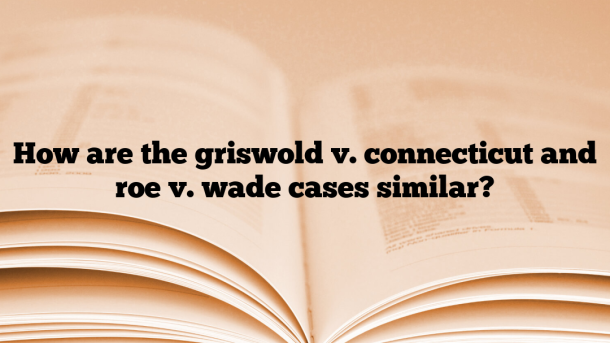How are the griswold v. connecticut and roe v. wade cases similar?
In the realm of constitutional law, certain cases stand as sentinels guarding the sanctity of individual rights. Griswold v. Connecticut and Roe v. Wade are emblematic of this role, serving as guardians of personal autonomy and privacy. This exploration delves into the perspectives of these landmark cases, examining how Griswold laid the groundwork as the guardian of marital privacy, and Roe extended this guardianship to encompass a woman’s right to make decisions about her own body.
Griswold v. Connecticut: Pioneering the Guardianship of Marital Privacy
Challenging Repressive Laws
Griswold v. Connecticut, decided in 1965, emerged as a response to repressive state laws that sought to regulate private aspects of individuals’ lives. The Connecticut Comstock Act of 1879 criminalized the use of contraceptives, even within the confines of marriage. Estelle Griswold, the executive director of Planned Parenthood League of Connecticut, and Dr. C. Lee Buxton challenged this law, arguing for the guardianship of marital privacy.
Landmark Decision: Recognizing Marital Privacy as a Constitutional Right
In a groundbreaking decision, the Supreme Court, led by Justice William O. Douglas, recognized a right to marital privacy. Justice Douglas argued that while the Constitution did not explicitly mention privacy, various amendments created zones of privacy, with the First, Third, Fourth, Fifth, and Ninth Amendments contributing to this constitutional protection. Griswold, therefore, became the vanguard in establishing the judiciary’s role as a guardian of personal choices within marital relationships.
Roe v. Wade: Extending Guardianship to Reproductive Autonomy
Challenging Reproductive Restrictions
Building upon the guardianship established in Griswold, Roe v. Wade, decided in 1973, confronted restrictive state laws that sought to regulate a woman’s reproductive choices. Norma McCorvey, under the pseudonym “Jane Roe,” challenged a Texas law criminalizing most abortions except to save the life of the mother. Roe expanded the scope of guardianship beyond marital privacy to include a woman’s right to choose to have an abortion.
Landmark Decision: Recognizing Reproductive Autonomy as a Guardian Right
The Supreme Court, with Justice Harry Blackmun writing the majority opinion, recognized a woman’s right to choose to have an abortion as part of her constitutional right to privacy. The decision categorized pregnancy into three trimesters, with different levels of state interest and regulation permitted in each. Roe became a powerful assertion of the judiciary’s role as a guardian of individual rights, extending its protective umbrella to include reproductive autonomy.
Judicial Guardianship: A Common Thread
Establishing the Judiciary as Guardians
Both Griswold and Roe cast the judiciary as guardians of individual rights, marking a departure from a more passive role. Griswold established a precedent for the Court to play a proactive role in protecting personal decisions from undue government interference. Roe, building upon this foundation, further solidified the judiciary’s position as a defender of individual liberties against laws that sought to infringe upon private choices.
Common Ethical Underpinning
The guardianship role assumed by the judiciary in Griswold and Roe rests on a common ethical underpinning – the recognition of the importance of personal autonomy and the right to make decisions about one’s own body. This ethical dimension underscores the judiciary’s commitment to safeguarding individual freedoms against legislative intrusion, marking a shift towards an active and protective stance.
Legal Framework: Due Process and Fundamental Rights
Due Process as the Common Denominator
The legal framework connecting Griswold and Roe is anchored in the Due Process Clause of the Fourteenth Amendment. Griswold argued that Connecticut’s prohibition on contraceptives violated the right to marital privacy protected by the Due Process Clause. Roe extended this reasoning to reproductive choices, asserting that a state law restricting access to abortion interfered with a woman’s fundamental right to privacy and personal autonomy.
Fundamental Rights Doctrine
Both cases drew upon the fundamental rights doctrine, asserting that certain liberties are so essential to individual freedom that they are protected against state infringement. Griswold laid the groundwork by identifying the right to privacy as a fundamental right, and Roe expanded this doctrine to include a woman’s fundamental right to make decisions about her reproductive health. This doctrinal extension forms a key element of the guardianship role assumed by the judiciary.
Evolution of Guardianship: From Marital Privacy to Reproductive Autonomy
Griswold’s Legacy in Roe
Griswold’s guardianship over marital privacy left an indelible legacy, influencing the trajectory of guardianship in Roe v. Wade. The concept of privacy, first articulated in Griswold, evolved from marital privacy to encompass personal autonomy in reproductive decisions. Griswold’s imprint on Roe underscores the intergenerational impact of legal precedents and the evolving nature of guardianship over individual rights.
Challenges and Advances in Guardianship
The journey from Griswold to Roe reflects societal progress but also highlights ongoing challenges in the guardianship of individual rights. While both cases affirmed fundamental rights, the struggle for reproductive rights continues. Griswold and Roe are integral chapters in an ongoing narrative, emphasizing the need for vigilance in protecting and expanding individual liberties. The legal continuum from Griswold to Roe represents an evolving understanding of the Constitution’s role in safeguarding personal choices.
Social Impact and Backlash: Guardianship in the Public Sphere
Social Impact of Judicial Guardianship
Griswold and Roe had profound social impacts, shaping public discourse and societal attitudes towards individual rights. Griswold faced opposition rooted in traditional values that questioned the legitimacy of a judicially implied right to privacy. Similarly, Roe ignited a protracted debate on the morality and legality of abortion, generating a social movement that persists to this day. The social impact of these cases highlights the complex interplay between legal decisions and societal values.
Backlash and Ongoing Debate
The guardianship assumed by the judiciary in Griswold and Roe was not without backlash. Traditional values clashed with the evolving understanding of individual rights, creating a societal divide. The ongoing debate surrounding reproductive rights and privacy reflects the enduring tension between guardianship over personal choices and opposition rooted in moral and ethical considerations.
Conclusion: Guardians of Individual Rights in the Constitutional Tapestry
Enduring Legacy and Ongoing Guardianship
In concluding this exploration, Griswold v. Connecticut and Roe v. Wade emerge as sentinels in the constitutional tapestry, guardians of individual rights in the face of legislative intrusions. Griswold’s guardianship over marital privacy laid the groundwork for Roe’s extension of protection to reproductive autonomy. The enduring legacy of both cases underscores the ongoing guardianship role assumed by the judiciary, prompting continued discussions about privacy, autonomy, and the ever-evolving landscape of constitutional law. As guardians of individual rights, Griswold and Roe remain powerful symbols in the ongoing struggle to balance personal liberties with societal values.



